Main Menu · Search ·Current Issue ·Contact ·Archives ·Centennial ·Letters to the Editor ·FAQs
 
|
The Society of Fellows is a Harvard institution perfectly understandable to the outside world--or at least to journalists. It matches nearly every positive and negative stereotype of the Ivy League, which makes it one of the most explainable components of the University. And yet it is obscure in its origins and purpose to Harvard people themselves.
The society has a strong foundational narrative. Abbott Lawrence Lowell, A.B. 1877, LL.B. 1880, Harvard's president from 1909 to 1933, sought to provide an alternative to the Ph.D. degree, which he believed smothered creativity under a mountain of requirements. Lowell's strictures against the "mass production of mediocrity" always make good copy; who--aside from Senator Roman Hruska supporting the Supreme Court nomination of G. Harold Carswell in 1970--has ever defended mediocrity? The other founder--and first president of the society, from 1933 until his death in 1942--was Lawrence J. Henderson, A.B. 1898, M.D. '02, a red-bearded pioneering biochemist, blood physiologist, philosopher, and sociologist, whose conversational manner (according to fellow sociologist George C. Homans '32, Jf '39) "was feebly imitated by the pile-driver." His classic work, The Fitness of the Environment (1913), was one of the first studies of how many of the physical and chemical properties of the world are precisely suited for the existence of life. Henderson fits the stereotype of the brilliant, eccentric don as closely as Lowell does that of the magisterial academic statesman. While both acknowledged the value of the Ph.D. in its place, they sought, in Henderson's words, "to provide an alternative path more suited to the encouragement of the rare and independent genius." (They actually used the g-word.) Each year eight young scholars would be chosen for three years of completely free investigations of their choice, with full use of Harvard facilities. The Prize Fellowships of Trinity College, Cambridge, were their model.
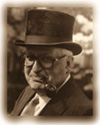 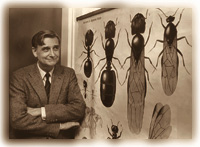
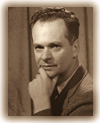
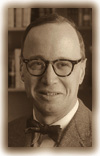 The Society of Fellows has incubated intellects from all disciplines. From top to bottom: Henry Rosovsky, international economist; E.O. Wilson, myrmecologist and sociobiologist; B.F. Skinner, psychologist (left); and Arthur Schlesinger Jr., historian. (ROSOVSKY) HARVARD NEWS OFFICE; (WILSON) JOE WRINN / HARVARD NEWS OFFICE; (SKINNER AND SCHLESINGER) HARVARD UNIVERSITY ARCHIVES
The Society of Fellows has incubated intellects from all disciplines. From top to bottom: Henry Rosovsky, international economist; E.O. Wilson, myrmecologist and sociobiologist; B.F. Skinner, psychologist (left); and Arthur Schlesinger Jr., historian. (ROSOVSKY) HARVARD NEWS OFFICE; (WILSON) JOE WRINN / HARVARD NEWS OFFICE; (SKINNER AND SCHLESINGER) HARVARD UNIVERSITY ARCHIVES |
Whatever may have happened to the décor of the former Freshman Union and the Faculty Club, the society's two rooms in Eliot House are authentically neo-Georgian Coolidge, Shepley, Bulfinch and Abbott, with full carved oak paneling, working grandfather clock, Oriental rugs, portraits, and sherry served on Oliver Wendell Holmes's original Autocrat's breakfast table. Port and madeira meander down the U-shaped table after dinner on a little trolley donated by Lowell. "What Price Decadence?" read a Harvard Independent headline in the 1970s with a typically cluttered illustration of the scene. (The room may be a feature writer's paradise, but it is a photographer's purgatory.) The only answer was J.P. Morgan's: If you have to ask, you can't afford it.
Even junior fellows were occasionally overwhelmed. Henderson was a Francophile who cherished the arts of living. "On the table were thirteen solid gold candle sticks with the name engraved on each as place cards," wrote the young B.F. Skinner to his parents, proceeding to describe "the best dinner I have ever eaten--sherry and bitters before, imported Dutch beer and cognac and other liqueurs afterwards. Green turtle soup and steak 3 inches thick." Politically and nutritionally dubious today, such fare must have been the ambrosia of the Depression-era intelligentsia, even if the original candlesticks were actually silver.
The actors hold even more interest than the sets. For the lay public, academic life is a realm of privileged discourse between the mature and the young, a Great Conversation on the arts and sciences. But as universities have necessarily grown more entrepreneurial, more intertwined with--and less distinguishable from--the business world, a disheartening measure of thought and action must go to meeting overheads through grantwriting and fundraising. For the outside reporter, therefore, the gathering of about 25 scientists and other scholars (mainly in their late twenties today) and about half that number of senior fellows (leading members of the Harvard faculty) is a return to academia's primal purity. The Society of Fellows suspends quotidian imperatives in an evening of interchange on ideas. In academia this is possible only by including such a range of natural sciences, humanities, and social sciences that disciplinary gossip no longer works --or rather, that it has to be explained to a neophyte.
The public imagines Harvard and other major universities to exalt research above teaching, and the society appears to fit its preconceptions. Junior fellows of the other and later Societies of Fellows at Columbia and Michigan also teach; Harvard junior fellows generally do not. The published criteria--"resourcefulness, initiative,...intellectual curiosity," and work holding "exceptional promise"--are silent about pedagogical gifts, though many fellows have, of course, become outstanding teachers. The attraction, and exoticism, of the society are precisely its three years without teaching or other obligations, such as the required public reading of papers in some other programs.
The Society of Fellows also embodies the Anglo-American success narrative. The society's alumni include a striking number of Harvard's, and academia's, stars, and the roster is part of the genre. While the typical former junior fellow is an upper-bracket solid citizen of academia, there is also a concentration of the charismatic and the prophetic, especially noticeable in the Kennedy and Nixon eras: Arthur Schlesinger Jr. '38, Jf '43; McGeorge Bundy, Jf '48, LL.D. '61; Daniel Ellsberg '52, Jf '59, Ph.D. '63; Kenneth Keniston '51, Jf '56; and Bruce Jackson, Jf '67, rank among the society's politically and socially engaged scholars. B.F. Skinner, Ph.D. '31, Jf '36, S.D. '85, Noam Chomsky, Jf '55, and E.O. Wilson, Ph.D. '55, Jf '56, stand out among the scientists. Philosopher W. V. Quine, Ph.D. '32, Jf '36, LL.D. '79, one of the original fellows, still attends many of the dinners. There are eight Nobel laureates among former junior fellows--and nine prizes, as physicist John Bardeen, Jf '38, S.D. '73, received two. The current chairman, molecular biologist Walter Gilbert '53, A.M. '54, received the Nobel Prize while a senior fellow, as did one of his predecessors, economist Wassily Leontief, and three other senior fellows.
For the media, it wouldn't be Harvard without a few rebels and international people of mystery. Robert Bakker, Ph.D. '76, Jf '76, the theorist of hot-blooded dinosaurs and consultant to the producers of Jurassic Park, recently did his first footwear endorsement. Paul de Man, Jf '57, Ph.D. '61, once one of the society's most revered literary alumni and still defended ardently by many former colleagues and students, became posthumously its most controversial upon discovery of his wartime collaborationist journalism in his native Belgium.
To complete the picture, there are poets, composers, spies, lawyers, and a handful of politicians and businesspeople. Alumni also include the computer-science pioneer Marvin Minsky '50, Jf '57; the director of the National Center for Supercomputer Applications, Larry Smarr, Jf '79; and the champion of on-line scientific publication, Paul Ginsparg '77, Jf '81--but in spring 1998 there was no computer scientist among the senior or junior fellows. This fact, too, is consistent with public perception that MIT, Carnegie-Mellon, Stanford, and corporate laboratories--rather than the Ivy League--are the true fonts of technological innovation.
The popular picture of the Society is not entirely wrong, but it is incomplete. The Society of Fellows has had a much more complex relationship with Harvard, at once marginal and deeply influential. It was the last of a series of institutions with which Lowell created much of the Harvard the visitor notices and the faculty and students use: Widener Library, Memorial Church, the original Houses.
 Patrons and beneficiaries: The Society of Fellows, 1933. Front row, from left: Thomas Chambers, Harvard presidents James B. Conant and A. Lawrence Lowell, John L. Lowes, Alfred North Whitehead, John Chester Miller, and Lawrence J. Henderson. Back row: B.F. Skinner, W. V. Quine, Dean of Arts and Sciences Kenneth Murdock, Garrett Birkhoff, Fred Watkins, and Charles P. Curtis. Photograph courtesy Society of Fellows
Patrons and beneficiaries: The Society of Fellows, 1933. Front row, from left: Thomas Chambers, Harvard presidents James B. Conant and A. Lawrence Lowell, John L. Lowes, Alfred North Whitehead, John Chester Miller, and Lawrence J. Henderson. Back row: B.F. Skinner, W. V. Quine, Dean of Arts and Sciences Kenneth Murdock, Garrett Birkhoff, Fred Watkins, and Charles P. Curtis. Photograph courtesy Society of Fellows |
The Society of Fellows was different from all of these. It was an elite within an elite, Harvard's Harvard, and as such evoked the full range of attitudes that elites do from those outside them. All the major New York foundations declined to contribute to the project, and Lowell finally endowed the society, initially anonymously, with most of his private fortune. The society's consideration only of nominated applicants makes elections manageable, but has alienated repeated sponsors of unsuccessful candidates. (A humanities professor at another Ivy League university told me that after the society did not accept an especially strong student, he and his colleagues saw no point in sending further letters.) Thus the society, for all of its trophies, engenders mixed feelings, as Harvard itself does in the wider academic community. "What future has a Fellow? Diehards have said that he has none, or ought to have none," acknowledged the early junior fellows George Homans and Orville T. Bailey, Jf '40, a neuropathologist, in their introduction to the society's biographical survey of 1959.
The differences between humanistic and scientific careers give the society multiple roles. Most work in the humanities and social sciences is still solitary; it is also more likely to lead to a book than to a series of papers. Natural scientists, especially postdoctoral fellows, are much more likely to be collaborating either face-to-face or electronically. One scientist described her life in the society as a welcome "humanizing" counterpoint to the daily laboratory work that was her real business. A postdoctoral fellow in science is a crucial team member as well as an individual thinker. The humanist fellow works alone, and will probably continue to do so. They may enjoy and profit from each other's company, yet they are following different paths as well as studying different subjects.
Partly because of the diversity of disciplines, the society has never formed the cohesive network that many other elite institutions have. The Institute for Advanced Study, at Princeton, has T-shirts; the society probably never will. There's no old school tie; unlike other units of Harvard, the society has no armorial bearings. There is no Masonic handshake, either. Harvard's culture of competitive individualism, a lasting consequence of Charles William Eliot's presidency, extends to the society itself. The fellows become friends, collaborators, and even (in at least two cases) marriage partners, but display less club spirit than some might expect. The high-minded and formal male conviviality that Lowell and Henderson imported from the literary clubs of Boston--a group they had organized, the Saturday Club, was a precursor--was already fading by the 1920s, let alone the 1930s. After World War II, the forms remained but the glamour faded from the Monday dinners except when some visiting celebrity appeared. While former fellows are welcome at dinners ("Once a junior fellow, always a junior fellow," the society's late administrator, Roberta Hill, liked to say), not many return.
Nor is there any special bond among most alumni. Two former fellows were mistakenly double booked into the guest suite above the dining room some years ago, and the second to arrive nearly threw the other's luggage into the hall. (And in intellectual matters they can be even more fierce. Introducing his 1959 review of B.F. Skinner's Verbal Behavior in a later anthology, Noam Chomsky extolled Skinner's work as "in effect, a reductio ad absurdum of behaviorist assumptions" with the "definite merit" that Skinner's ideas were the very best that behaviorism or empiricism could ever offer on language.) Further, given the qualifications and scientific versatility of many junior fellows, it is striking how few of them have become the political and business leaders--"men who will do the work of the world"--that Henderson expected and encouraged. There have been foundation directors but no secretary of state, governor, member of Congress, Supreme Court Justice, or president of a national research university. Ivan Getting, Jf '41, a physicist whose work at the MIT Radiation Laboratory saved countless thousands of Londoners during the V-1 attacks and who helped found Raytheon, is the only major industrialist. The few political stars, including McGeorge Bundy and the economist Carl Kaysen, Jf '50, Ph.D. '54, have generally been senior advisers rather than executives.
The Society of Fellows has had a paradoxical mission. It was to select young people, originally young men, who would break the power of the academic departments with their Germanic systems of apprenticeship. Yet these people would have to be nominated largely by prominent figures of the very organizations they were meant to challenge. And once their terms were over, they would have to be accepted by the same departments at Harvard and elsewhere. While they might eventually nominate junior fellows in their turn, much of their careers would be spent, and were indeed spent, supervising Ph.D.s. Unlike All Souls College, Oxford, and the more worldly think tanks that flourished during the Cold War, the society was to have no permanent or even visiting senior researchers.
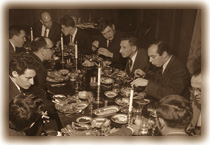 Silver gets in your eyes: B. F. Skinner was dazzled by the society dinners, like this 1950s lobster fest. Photograph courtesy Harvard University Archives
Silver gets in your eyes: B. F. Skinner was dazzled by the society dinners, like this 1950s lobster fest. Photograph courtesy Harvard University Archives |
At the 1996 celebration of the retirement of the mathematician Andrew Gleason, Jf '50, as chairman of the society, McGeorge Bundy extolled the society's ideal as "freedom from Harvard." The junior fellowship thus was the ultimate act of Harvard's generosity: bringing in young people to emancipate from itself.
Yet Harvard, including the Society of Fellows, needs vigorous departments. And the society strengthened Harvard immensely. At the same meeting, the speech given by Henry Rosovsky, Jf '57, Ph.D. '59, LL.D. '98, consisted almost entirely of a recital of the names of the 81 former junior fellows who had held tenured appointments in the University, most of them in the Faculty of Arts and Sciences. It was not just a large number, but included more than its share of the most productive and influential professors.
The infusion of former junior fellows has brought excellent people into graduate education, but they could not change those features of it that Lowell and Henderson had found objectionable. Even bold and controversial professors usually train disciples rather than abet rebels. The arts and sciences Ph.D. is still part of a social system requiring earlier specialization than the M.D. (Henderson's degree), the LL.B. (Lowell's degree, now generally J.D.), or the M.B.A. And it is defended more firmly than ever, often as a progressive, egalitarian alternative to the Oxbridge high-table world that Lowell represented. It was Lowell, after all, who unabashedly sought restrictions on Jewish and black students in the name of Anglo-Saxon cultural values.
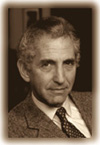
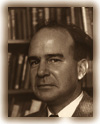 
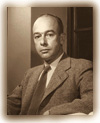
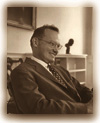
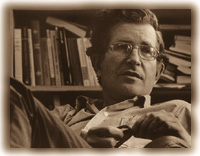 Fellows worldly and otherworldly: Daniel Ellsberg of Pentagon Papers fame; George C. Homans, sociologist; Walter Gilbert, molecular biologist and Nobel laureate; W. V. Quine, philosopher; McGeorge Bundy, political scientist; Noam Chomsky, linguistics pioneer.
(ELLSBERG) JIM HARRISON, (HOMANS, QUINE AND BUNDY) HARVARD UNIVERSITY ARCHIVES, (GILBERT) JANE REED, (CHOMSKY) CHRISTOPHER S. JOHNSON
Fellows worldly and otherworldly: Daniel Ellsberg of Pentagon Papers fame; George C. Homans, sociologist; Walter Gilbert, molecular biologist and Nobel laureate; W. V. Quine, philosopher; McGeorge Bundy, political scientist; Noam Chomsky, linguistics pioneer.
(ELLSBERG) JIM HARRISON, (HOMANS, QUINE AND BUNDY) HARVARD UNIVERSITY ARCHIVES, (GILBERT) JANE REED, (CHOMSKY) CHRISTOPHER S. JOHNSON |
The academic disciplines of Henderson's and Lowell's time have been joined by new movements and trends: history and philosophy of science; area studies; then cultural, women's, and ethnic studies. Junior fellows have been prominent in these tendencies. Henry Rosovsky recalls his days as a Harvard graduate student, when studying the Japanese economy was still an exotic idea to his teachers. He believes the society deserves much credit for encouraging area studies at Harvard and elsewhere while established departments were still skeptical. But the new fields redefined rather than attacked the logic of specialization. Committees graduated to programs, programs to departments. The right to grant the Ph.D. has been the ultimate prize. No proposed alternative terminal degree in the arts and sciences has succeeded. The postwar global influence of U.S. higher education, to which so many former junior fellows contributed, has naturalized this originally German credential as surely as time has Americanized such German artifacts as the hamburger, the harmonica, and the bowling ball. A significant number of the junior fellows now come for postdoctoral study from European, Russian, and East Asian institutions. William James's "Ph.D. Octopus" is us.
The historian and philosopher of science Thomas Kuhn '44, Ph.D. '49, Jf '51, shows both the success and the limits of the society's goals. Kuhn was one of the stars of the society's 1950s--"the golden decade, when everything was possible" as E.O. Wilson called it in his speech at the Gleason dinner. Kuhn's Structure of Scientific Revolutions became one of the world's scholarly bestsellers. Yet unlike some other popularly acclaimed scholars, he was extremely concerned about his peers' opinions, especially about those of philosophers, and once reflected that he almost preferred his critics to his fans. Kuhn valued "normal science," the ongoing work of established research communities. He saw an "essential tension" between the conservative and radical modes of science; the same might be present in the relationship of innovations like the Society of Fellows itself to the conventional academy.
The Society of Fellows has been rendered less quaint, but also less important, by its own success in helping invigorate American graduate education. It began as the last major award in one's career for sheer promise; it has become instead the first big prize for actual achievement. A few graduate students have always been prepared to decline junior fellowships for attractive tenure-track positions. (Such offers were known, but less frequent, in the Depression when the society began.) Today the fellowship is on a par with an assistant professorship at a major research university, and a significant number of successful nominees accept such appointments instead.
The society thus illustrates a tendency first observed by the sociologist Robert K. Merton: obliteration by incorporation. When a scientist's thought becomes sufficiently influential, other researchers may refer to the original papers less and less often, precisely because these are the foundation of the current work that is cited. How many contemporary physics papers have direct references to Newton or Helmholtz? It was the destiny of Heinrich Hertz to become mainly the third syllable of megahertz. Technological innovators, social reformers, and political leaders can be swallowed up and digested by their own success.
The Society of Fellows has not been obliterated. It is a vigorous organization that continues to attract remarkably gifted men and women as both junior and senior Fellows. Not only Harvard, but many other institutions have been enriched by former junior fellows. Lowell, Henderson, and the other original senior fellows would not have been pleased with all directions of contemporary scholarship, but they would almost certainly have been delighted by its strength and depth.
Henderson, who used to challenge the early junior fellows with the bracing doctrines of the elitist Italian economist and sociologist Vilfredo Pareto, would have been crestfallen to find his hero so out of favor. But he would almost certainly be awed by the results of biochemistry and molecular biology at Harvard since his day. He would have been pleased to find The Fitness of the Environment now awarded as an undergraduate prize in his honor in the department of chemistry and chemical biology. He would have been especially happy to see a full department in the fledgling field of the history of science that he encouraged, with several former junior fellows in its ranks. But this professionalization has ultimately meant that those scientists who want to write history need special training unknown in Henderson's day. Successful collaboration and interchange among disciplines promotes formation of new ones that in turn present fresh challenges to communication.
Declaration of PrinciplesYou have been selected as a member of this society for your personal prospect of serious achievement in your chosen field, and your promise of notable contribution to knowledge and thought. That promise you must redeem with your whole intellectual and moral force. You will practice the virtues, and avoid the snares, of the scholar. You will be courteous to your elders who have explored to the point from which you may advance; and helpful to your juniors who will progress farther by reason of your labors. Your aim will be knowledge and wisdom, not the reflected glamour of fame. You will not accept credit that is due to another, or harbor jealousy of an explorer who is more fortunate. You will seek not a near but a distant objective, and you will not be satisfied with what you may have done. All that you may achieve or discover you will regard as a fragment of a larger pattern of the truth which from the separate approaches every true scholar is striving to descry. To these things, in joining the Society of Fellows, you dedicate yourself. |
The Society remains a vital part of Harvard, indeed an ever more internationally recognized one, but its years as a radical (or conservative) experiment appear long over. I say appear because the society's by-laws permit wide discretion to the chairman and senior fellows in selecting their junior colleagues. There are no quotas on fields. The society is always free to reshape the fellowships by choosing more boldly or more cautiously. And like other elite programs that emphasize making a difference (as opposed to recognizing those people who will ultimately be most successful anyway), it takes risks either way.
Evaluating elite programs is never easy. The more selective and prestigious these programs are, the harder it is to determine what the institution has added. And since the society selects not only for promise but for aptitude for self-directed work, would such young men and women not be equally successful and innovative without junior fellowships?
By the usual measurements, by tenured appointments and publications and prizes and society officerships, it cannot be proved that the society has made a difference. But that was never its main purpose. The principles of the founders were two.
The first was a high sense of the ethical responsibilities of scholarship. At the first dinner of the year, before signing the register, each new group of fellows hears a statement of scholarly ideals--the Declaration of Principles--written by Lowell himself. Sonorous as it may be to today's tastes, it can also be a moving document, one that many fellows remember vividly. Henry Rosovsky, for example, believes it inspired him to pursue his current project of developing professional standards of conduct for the graduate curriculum and the faculty.
The second was to promote the subtle changes that take place when people from across the world get to know each other over three years. It is the junior fellows' chance to get to understand not just the published ideas or formal lectures of some of Harvard's outstanding faculty members, but their personalities, their styles of analysis and speech. And it is equally the chance to see something of the minds of peers who would otherwise be immersed in their own departments. As a junior fellow, I had no idea how important my colleagues' ideas and observations would ultimately be, how some phrase uttered casually over an after-dinner beer would ultimately become almost a mantra. Society of Fellows might seem a redundant expression, as junior fellow is an ostensibly diminutive one: like a "club of members." But the name is apt even if the process is elusive.
Under leaders as diverse as Henderson, the historian Crane Brinton '19, Wassily Leontief, the philosopher Burton Dreben '49, Jf '55, Andrew Gleason, and Walter Gilbert, the Society of Fellows has in its own circuitous way been a powerful force in the making of the Harvard faculty. Henderson later in life doubted the philosophical foundations of his early writings, according to his biographer, John Parascandola. But the environment that he and Lowell created has, in its 65 years, proved even fitter than he imagined.